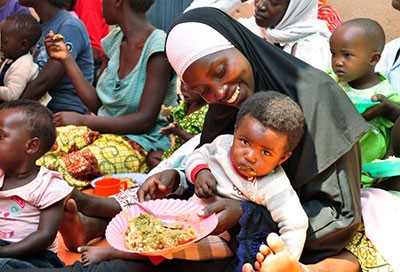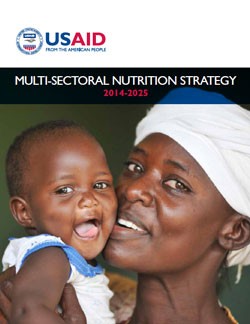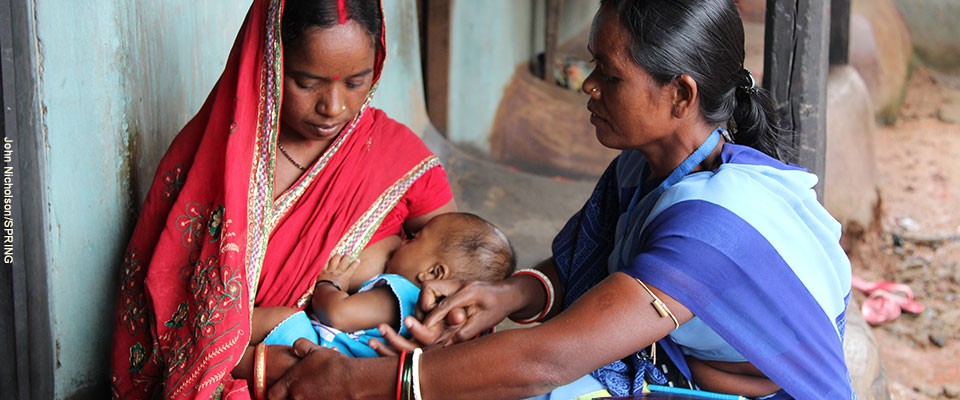- What We Do
- Agriculture and Food Security
- Democracy, Human Rights and Governance
- Economic Growth and Trade
- Education
- Ending Extreme Poverty
- Environment and Global Climate Change
- Gender Equality and Women's Empowerment
- Global Health
- Water and Sanitation
- Working in Crises and Conflict
- U.S. Global Development Lab
-
Learn More
Discover more about our priority countries.
-
Learn More
Learn more about our partnerships and efforts.
-
Learn More
Read our series of technical guidance briefs for more information on various nutrition-related topics.
-
Learn More
Visit our stories section to learn more about these Nepali mothers and young children as well as the many other women, children, and families worldwide that benefit from USAID nutrition efforts.
As a result of USAID's integrated efforts, more than 27 million children under 5 were reached by nutrition interventions in 2016 alone.
More than a quarter of the world's children under the age of 5 years suffer from undernutrition. This includes 155 million children who are stunted as a result of chronic undernutrition and other limiting factors during the most vulnerable years of a child's life. It also includes 52 million children who are affected by wasting, a result of severe illness and undernourishment and a major cause of mortality.1 Undernutrition leaves children vulnerable to disease, impoverishes families, diminishes community resilience, and reduces critical human capital and capacity, thereby causing long-term detriment to national economies and social development.

Nutrition investments have one of the highest returns on investment – every $1 invested in nutrition results in up to $35 in economic returns.2 USAID investments address the prevention of all forms of malnutrition, with emphasis on those that target the "1,000 day window of opportunity" from pregnancy through a child's second birthday – a period in which good nutrition is critical for optimal physical and cognitive development. By improving nutrition, USAID helps national economies grow, enabling them to better participate in global markets and provide for their own citizens. USAID expands evidence-based approaches to nutrition and uses proven, cost-effective methods to improve global health and nutrition outcomes for the most vulnerable populations.
The Agency's strategic approach to maternal and child nutrition focuses on increasing:
- The equitable provision and utilization of high-quality nutrition services through nutrition-specific and nutrition-sensitive services and commodities as well as social and behavior change strategies for nutrition activities
- Country capacity and commitment to nutrition at the institutional, political, stakeholder, and systems levels
- Multi-sectoral programming and coordination for improved nutrition outcomes including the strengthening of cross-sectoral planning, coordination among nutrition stakeholders in the U.S. Government and host governments, and engagement with the private sector
- Nutrition leadership through strengthening both the development and use of evidence-based approaches and innovative practices.

Between 2009 and 2016, the prevalence of stunting within USAID's 19 nutrition priority countries decreased from 40 percent to 34 percent. As outlined in the agency's Multi-Sectoral Nutrition Strategy 2014–2025, USAID continues to leverage its role as a key international partner in the fight against malnutrition to address both the direct and underlying causes of malnutrition worldwide. Using this strategy, USAID aims to contribute to the global goal of a 20 percent reduction in stunting by 2025, one of 6 global nutrition targets for 2025 set by the World Health Assembly (WHA) in 2012.
USAID's maternal and child nutrition programs set the direction and ensure technical excellence of diverse nutrition programs across the Agency. Maternal and child nutrition programs improve health outcomes by implementing nutrition-specific interventions,3 or those that address the immediate, health-related determinants of malnutrition. Nutrition-specific interventions alone, however, cannot fully eradicate undernutrition. USAID also coordinates across the Agency to support nutrition-sensitive interventions – those that address underlying or systemic causes of malnutrition, including the integration of nutrition components into programs that focus on education, WASH, agriculture, and healthy timing and spacing of pregnancy. By working within and across the agency to coordinate nutrition-specific and nutrition-sensitive interventions, USAID's maternal and child nutrition programs leverage other investments and have a greater impact on improving health.
USAID is maximizing American investments in nutrition to boost prosperity and enhance the health and livelihoods of vulnerable populations. As a result of USAID's integrated efforts, more than 27 million children under 5 were reached by nutrition interventions in 2016 alone.4 Through a combined effort of USAID's nutrition-specific programs, nutrition-sensitive interventions, crisis response efforts, and development and humanitarian programs, U.S. assistance is driving nutrition improvements and improving health around the world.
Learn more about other resources and collaborations that guide maternal and child nutrition programs on the Resources page.
Footnotes
1 2016 Global Nutrition Report
2 An Investment Framework for Nutrition : Reaching the Global Targets for Stunting, Anemia, Breastfeeding, and Wasting
3 USAID's Multi-Sectoral Nutrition Strategy, guided by The Lancet 2013 Maternal and Child Nutrition series [PDF, 3.6MB], identifies 11 nutrition-specific interventions: management of severe acute malnutrition, preventive zinc supplementation, promotion of breastfeeding, appropriate complementary feeding, management of moderate acute malnutrition, periconceptual folic acid supplementation or fortification, maternal balanced energy protein supplementation, maternal multiple micronutrient supplementation, vitamin A supplementation, and maternal calcium supplementation.
4 Feed the Future Progress Report [PDF, 12.7MB]











Comment
Make a general inquiry or suggest an improvement.